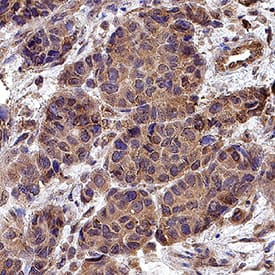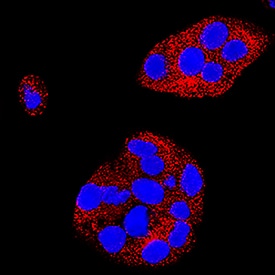Human DLL1 Antibody
R&D Systems, part of Bio-Techne | Catalog # MAB18181

Key Product Details
Species Reactivity
Validated:
Cited:
Applications
Validated:
Cited:
Label
Antibody Source
Product Specifications
Immunogen
Ser22-Gly540
Accession # AAG09716
Specificity
Clonality
Host
Isotype
Scientific Data Images for Human DLL1 Antibody
DLL1 in HepG2 Human Cell Line.
DLL1 was detected in immersion fixed HepG2 human hepatocellular carcinoma cell line using Mouse Anti-Human DLL1 Monoclonal Antibody (Catalog # MAB18181) at 25 µg/mL for 3 hours at room temperature. Cells were stained using the NorthernLights™ 557-conjugated Anti-Mouse IgG Secondary Antibody (red; Catalog # NL007) and counterstained with DAPI (blue). Specific staining was localized to cytoplasm. View our protocol for Fluorescent ICC Staining of Cells on Coverslips.DLL1 in Human Breast Cancer Tissue.
DLL1 was detected in immersion fixed paraffin-embedded sections of human breast cancer tissue using Mouse Anti-Human DLL1 Monoclonal Antibody (Catalog # MAB18181) at 1.7 µg/mL for 1 hour at room temperature followed by incubation with the Anti-Mouse IgG VisUCyte™ HRP Polymer Antibody (VC001). Before incubation with the primary antibody, tissue was subjected to heat-induced epitope retrieval using Antigen Retrieval Reagent-Basic (CTS013). Tissue was stained using DAB (brown) and counterstained with hematoxylin (blue). Specific staining was localized to cytoplasm in cancer cells. Staining was performed using our protocol for IHC Staining with VisUCyte HRP Polymer Detection Reagents.Applications for Human DLL1 Antibody
Immunocytochemistry
Sample: Immersion fixed HepG2 human hepatocellular carcinoma cell line
Immunohistochemistry
Sample: immersion fixed paraffin-embedded sections of human breast cancer tissue
Formulation, Preparation, and Storage
Purification
Reconstitution
Formulation
Shipping
Stability & Storage
- 12 months from date of receipt, -20 to -70 °C as supplied.
- 1 month, 2 to 8 °C under sterile conditions after reconstitution.
- 6 months, -20 to -70 °C under sterile conditions after reconstitution.
Background: DLL1
Delta-like protein 1 (DLL1) is a 90‑100 kDa type I transmembrane protein that belongs to the Delta/Serrate/Lag-2 (DSL) family of Notch ligands. Mature human DLL1 consists of a 528 amino acid (aa) extracellular domain (ECD) with one DSL domain and eight EGF-like repeats, a 23 aa transmembrane segment, and a 155 aa cytoplasmic domain (1). Within the ECD, human DLL1 shares 91% aa sequence identity with mouse and rat DLL1. It shares 26%, 37%, and 54% aa sequence identity with DLL2, 3, and 4, respectively. A 60 kDa ECD fragment released by ADAM9, 12, or 17 mediated proteolysis, promotes the proliferation of hematopoietic progenitor cells (2, 3). The residual membrane-bound portion of DLL1 can be cleaved by presenilin-dependent gamma-secretase, enabling the cytoplasmic domain to migrate to the nucleus (4). DLL1 localizes to adherens junctions on neuronal processes through its association with the scaffolding protein MAGI1 (5). DLL1 is widely expressed, and it plays an important role in embryonic somite formation, cochlear hair cell differentiation, plus B and T lymphocyte differentiation (6‑11). The upregulation of DLL1 in arterial endothelial cells following injury or angiogenic stimulation is central to postnatal arteriogenesis (12). DLL1 is also overexpressed in cervical carcinoma and glioma and contributes to tumor progression (1, 13).
References
- Gray, G.E. et al. (1999) Am. J. Pathol. 154:785.
- Dyczynska, E. et al. (2007) J. Biol. Chem. 282:436.
- Karanu, F.N. et al. (2001) Blood 97:1960.
- Ikeuchi, T. and S.S. Sisodia (2003) J. Biol. Chem. 278:7751.
- Mizuhara, E. et al. (2005) J. Biol. Chem. 280:26499.
- Takahashi, Y. et al. (2003) Development 130:4259.
- Teppner, I. et al. (2007) BMC Dev. Biol. 7:68.
- Kiernan, A.E. et al. (2005) Development 132:4353.
- Schmitt, T.M. and J.C. Zuniga-Pflucker (2002) Immunity 17:749.
- Hozumi, K. et al. (2004) Nat. Immunol. 5:638.
- Santos, M.A. et al. (2007) Proc. Natl. Acad. Sci. 104:15454.
- Limbourg, A. et al. (2007) Circ. Res. 100:363.
- Purow, B.W. et al. (2005) Cancer Res. 65:2353.
Long Name
Alternate Names
Gene Symbol
UniProt
Additional DLL1 Products
Product Documents for Human DLL1 Antibody
Product Specific Notices for Human DLL1 Antibody
For research use only

